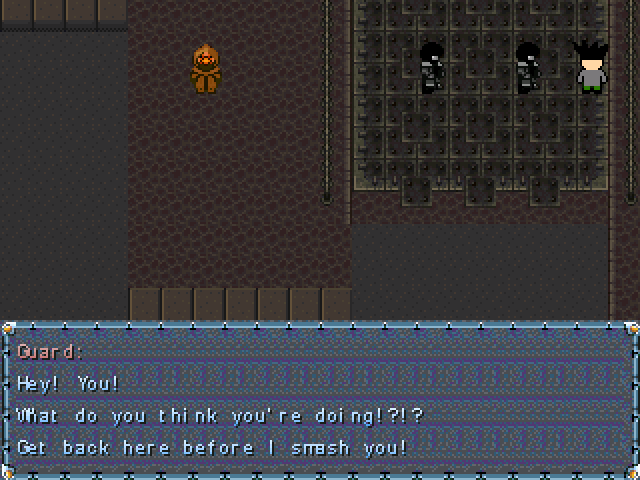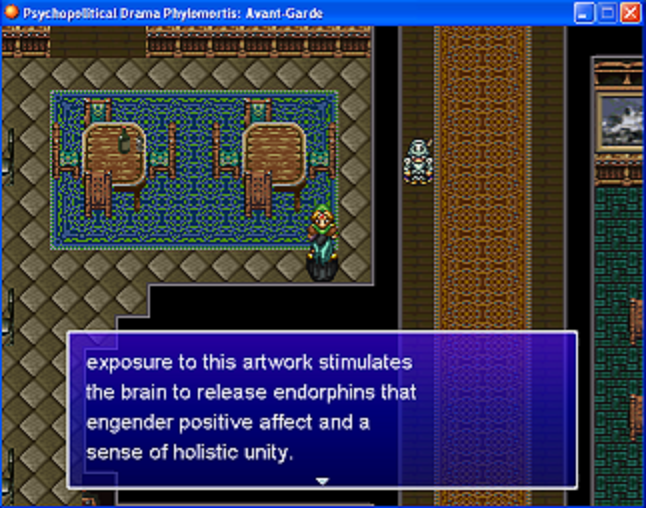
Phylomortis

|
THREE TILE RULE:
rarely seen in the wild, invented to reduce the problem of "huge, square rooms with a single closet and a bed in one corner" which has been haunting RM developers for decades. from memory the law was that you should never have more than three of the same tile in a row, because otherwise there's too much empty space. it's not a bad one but it does touch on a recurring formal problem at the heart of these games, which is the back and forth between scope and density. the jewelbox conception of closely packed and exquisite little spaces is basically alien to the mechanical and narrative language of the rpg format, which can only parse such spaces as filler to blow past in the search for more, more, more, the endlessly expanding scope. i remember every so often there being a kind of wistful symposium on the question of the short, compressed scenario game, the equivalent of just making one of the arcs in Live A Live or the haunted train section of FF6 instead of a whole 20 hour voyage. smaller games which would both be more achievable and more conducive to precise, detailed mapping and design. and everyone agreed that this would be good and then went back to their 20 hour dream projects, since part of the pleasure in making these things was the indefinite suspension of the kind of limits that "craftsmanship" is designed to acknowledge and to work around. |
|
OVERLAYS:
a static image projected on top of the game map, usually light and shadow, or foliage - another battlefield in the constant struggle to lend a sense of depth and visual charge to what is essentially a flat plane made up of uniform squares. it'd be interesting to have some kind of survey on how many videogame remakes, remasters, were able to avoid tinkering with the lighting systems - i'm thinking of things like the notorious bloom lighting in wind waker hd, or the fog in silent hill 2 remastered, glowy neon pacman deluxe remasters... i feel like a large proportion of them must, and that as well as wanting to show off all the fancy new rendering tools available since the original came out, at least some of this is to try and match the sense of charged presence that exists in our memory of the original thing. the lightmaps i recall were generally sludgy and illegible as well as baffling in terms of the actual light sources they represented... it's interesting to imagine these evolving into kind of a shoegaze direction, just a wall of shifting visual noise and effect hanging over the bare outlines of an actual game, strangling all life, stifling all movement. |
|
MUSIC:
videogame midis. pop songs considered slightly gauche. mp3s are fancy but also resented slightly in this bygone context of limited disk space and capped download speeds: the 10mb high quality orchestral version of one winged angel was a frequent cause for outcry. custom music respected but generally seen as unreachable for the general populace. i remember alter a.i.l.a.(?) used some metal song as the battle theme, an effect that i enjoyed. |
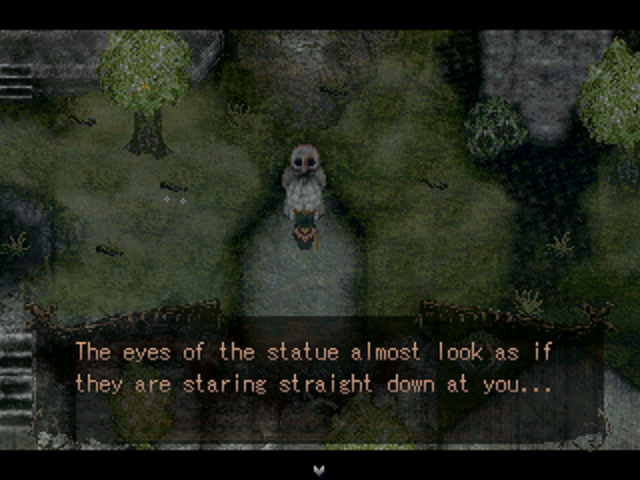
|
LISTS:
we mock now but for a long time compiling big list of examples was considered the most useful form of scholarship and the task of writing about some subject ("do griffins exist in nature?") was in part that of dutifully summarising and quoting any relevant mentions of the topic that appeared in ovid, pliny, galen, gesner, goltsius, etc. we know that herodotus refers to the griffin as a "large swan of baleful aspect" while the venerable bede instead named it as "a type of cart, which sits six people". this tradition achieved new life in the form of the cracked dot com listicle, which is where i first encountered it, and i remember for a long time my attempts to figure out whether such-and-such "could be done" consisted mostly of trying to write out a big list of games that involved or might involve similar sequences, and then to look at the list, and feel i was Musing. it would be interesting to look at the way the list format emerges within a young, diffuse community, as a way to establish a shared reference pool which could then be pulled and sampled from to lend rhetorical weight to a given position. |
|
FINISHED GAMES:
these have their own subforum, tucked away inside the main game development board. the comparative lack of posts, activity and bustle makes it feel like an illustrious grave. |
|
CLICHE:
things were cliche because they worked, or else they were cliche because they no longer worked, and so cliche was good, or bad, or which? this thorny issue came up over and over and i think represented a form of ongoing community negotiation between the realms of private fantasy and public dialogue. nobody wants to have their inner life policed and i think to a large extent that inner life thrives on cliche, doggerel, repetition, half-remembered gestures, all those things which seem to emerge without source from the night memory, and hence provide the dual pleasure of recognition and discovery. but there's something unpleasant about other people's fantasy lives, and in seeing your own in them, about your own rich subjective world being basically not that dissimilar to this other guy's ongoing attempt to recreate old plotlines of naruto except with dragon people. i think the eventual compromise is that nobody would be criticised for unoriginality as long as they stopped making games about people with amnesia. |

|
CANON:
whenever you open an rpg maker editor there's a splash screen showing an unlikely and excited assortment of adventurers, at exactly the right balance of the generic and the individual, in the middle of some fantastic voyage that takes them right out of the screen: in an airship, or leaping over a hill... and it's the perfect encapsulation of the sort of fantasy of rpg maker: your dreams and desires can become more real and more individuated while retaining something of that limitless, unbounded, unending sense of possibility. and i'm tempted to say that the rpg maker canon must be split in two, and that this fantasy is the boundary line. first there's the group of distinctive and original games which inspire artistic respect, which do their own thing within a specific and deliberate range: games like a blurred line, sunset over imdahl, the way 1-6... finished one-offs. they're good games but in a way which discourages direct imitation or continuation: the fact that they're complete, that they've done just what they decided to do, is part of their power, but it also limits their hold on the imagination, and their influence. the second group consists of the games which were more likely to be the ones that originally lit a fire under someone's brain: the messy, grandiose, sprawling adolescent projects, which were crude enough to give a sense you might improve on them but still passed on some idea of the potential for the engine. games like devil hunter: seeker of power, or final fantasy blackmoon prophecy, or of course don miguel's adventure. games less frequently cited as an influence but all the more influential for their status as "raw materials", as collections of assets and techniques to be pulled from and repurposed. |
|
HOSTING:
interestingly not considered to be a big deal, which meant most games being stored on a motley network of private hosting domains, upload sites, small-scale "lockers" attached to the forums themselves or on other people's fansites. with the resulting impact on game preservation being what you'd expect. although it could also mean that somebody's copy of Legends Of Alteria Demo or similar will still be sitting safely in an overlooked college server somewhere after all the more wide-ranging and upkeep-intensive hosting sites have once again returned to dust. |
|
RTP:
run time package - the set of default resources which came with rpg maker and were mostly required to play the games. the default graphics are always interesting since i'm convinced that what seem like intentionally generic placeholders over here are actually specific callbacks to different eras of the jrpg - rm2k/3 seems to me modelled specifically on the dragon quest remake games for snes, and the strangely sterile, crisp graphics for RMXP and onwards draw more on the similarly-toned higher-res graphics of the PC98 generation... anyway whatever the source these graphics formed a clear and easy means of identifying those who had supposedly not put the legwork in, in essentially the same way today as we would talk about "unity store assets", or even just "unity". from memory actual RTP games were rarer to see in the wild than their reputation would suggest, but their rhetorical role was important as giving everybody else something to feel better about, a way of climbing slightly higher up the ladder from the despised hobbyist / amateur niche. |
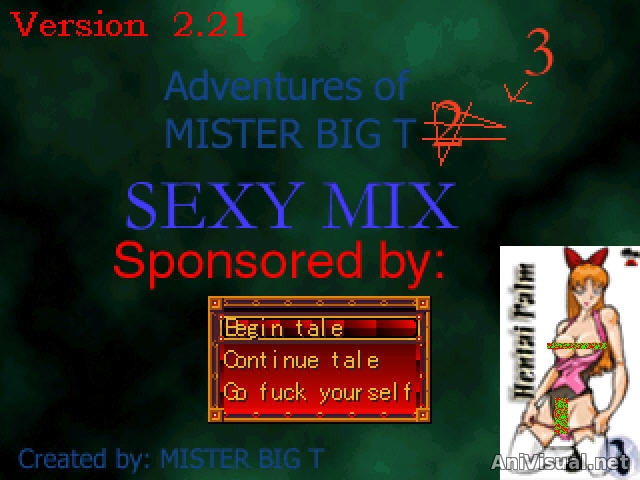
|
RPG REVIEWER:
somebody with a username like "TheRPGReviewer" or "OfficialRPGReviewer" who appeared on forum threads and rated the game along the five canonical humours of Gameplay, Graphics, Music, Story, and Overall, and capped it all with an image reading like "you have been graded by OfficialRPGReviewer... good day." a slightly ominous reminder of the human ability to both identify and adapt to a social niche, without anybody asking them to or knowing about it. |
|
CATERPILLAR SYSTEM:
basically when your party members follow the main character around the screen instead of being absorbed into a single sprite; raises many interesting questions of position, variable tracking, global event calling and exception handling when constructed via RM2k/3's event editor, and i suspect for many other people as well the point where a private line was drawn betweeen "enjoyment of a technical challenge" and "absolutely too tedious to keep up with". |
|
COMMERCIAL GAMES:
verboten mostly for sound legal reason but also for a certain prudery; how dare the Laxius Force games charge money, when they're of such lesser quality than the screenshot thread darlings carefully chopped together from only the finest SNES edits and being for that reason mostly unsaleable? also, the idea of the commercial world existing only for products of a certain professional quality kind of ground against the fact that all rpg maker games existed as part of the same spectrum and that nothing seems as impressive when you can just open it up and take a look at the innards. insufficiently mystified means of production for transition to full capitalism, try again later. |

|
RUDRA:
a tileset but also a lifestyle; a very rich and ornate set of level tiles, originally taken from Legends Of Rudra and originally reused i think in Balmung Cycle Part 1. for whatever reason (breadth, consistency, prettiness, ability to sync well with others?) became the favoured choice of the more graphical-quality-oriented developers who hung around the screenshot thread. and so also became useful as a term of mockery directed at the same developers: "rudra" came to be identified with a pedantic obsession towards one certain more or less homogenous form of visual polish. and i think eventually the rudra tiles themselves came to be seen as a little embarrassing and overused, came to signify the same rpg-maker-ness that they were originally intended to escape, and coupled with the difficulty of editing them into the wider tiles used by upcoming engines like RMXP eventually fell back into obscurity. but they're still out there, languishing in forgotten project holders, waiting to be revived once again... |
|
POKEMON HUNTER:
a series of 4 (or more?) full games by halibabica which i remember being played bizarrely straight - generic rpgs but with pokemon used as the enemies. in my memory these were strangely gory and melodramatic as well - i think i used the "blood" sprite set for my own unfinished teenage game because it was very good in a splattery way, even if about half of it was also filled with dead squirtles. |
|
AAA GAMES:
i had never encountered a popular art form with so little legitimacy, or which seemed to be held in such widespread and well-justified contempt, as the mid-2000s AAA videogames. if you had told me we would still be making these things in ten years i would have been surprised, but also i would have accepted it, since what was the alternative? |
|
INDIE GAMES:
sometimes people post or talk about games done in different editors and i more or less just assumed that this checked out - i was using rpg maker, after all, so presumably software for other genres already existed, even outside of gamemaker or adventure game studio. i think i got access to the internet slightly later than most americans my own age so there was never really a ground zero without some form of tiny homebrew computer gamedev going on in the background. i don't remember giving it much thought, or thinking "indie games" was anything other than another loose grouping of hobbyist forums more or less mirroring the rpg maker kind, and with the same kind of both artistic and commercial horizons. |
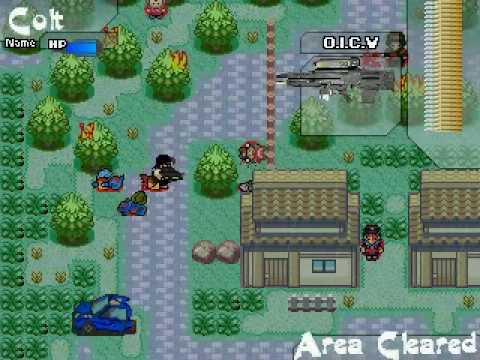
|
MONOPOLO:
a strange collision between the screenshot-hype-train and bizarre-technical-follies elements of rpg maker 2003. monopolo was a functioning clone of monopoly, mysteriously made in rpg maker by forum member silver4donuts, which is usually the sort of thing which just gathers mild praise and then gets stashed away in a custom-menu-showcase section of queenscourt.org or something. except in this case it was promoted as though it was a hyperanticipated blockbuster - regular screenshot drops, announcement pages, teaser links, all written up in a series of strangely formatted longform text posts written in a sort of giddy reggie-fils-aime-speak filled with weird winking insinuations, callbacks to previous posts, claims and grand rhetorical asides... and would never stop, bouncing back a week or two after every new round of increasingly aggressive insults and threatened disciplinary action. i remember being sad when the pushback eventually got to a point where it was dumber and more obnoxious than any of the original posts, one of those moments where "fair game" is declared and everyone can giddily go after an approved target. the last i heard a completed monopolo was still sitting on his hard drive somewhere - waiting until the time was right. |
|
MUMMIES:
i remember once i decided to download an RM game entirely at random and go in blind. and it started on a ship... the main character had angered the gods, who shipwrecked him on a strange coast, and he wakes up with amnesia. he walks into a cave, and the cave is full of mummies walking around at random. touching a mummy throws you into a fight. the mummy cave went on for three progressively larger and more complicated floors, after which the main character came out the other side with no further comment. it's easy to forget how aimlessly strange videogames are able to be. |
|
EMOTION:
i don't remember very many happy rpg maker games! for the most part i recall a sort of strained, terse, determined mood - hardened professionals or angsty youths being drawn into dark, wideranging martial struggles, etc... surely part of it was just general adolescence or the prevalent tastes of a time when every game seemed to be set inside a warehouse, and some of it was probably defensiveness against claims of self-indulgence or childishness, in playing with this accessible engine. but i think part of it as well is that rm games were partly an excuse to fantasize, and i think nobody really likes their own fantasies that much, or feels completely comfortable with them, in presenting them to other people. the characters in these games move tightlipped and suspiciously through the world, determined never to give in completely to the con. |
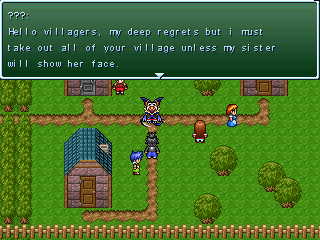
|
RPG MAKER 3D:
the beautiful dream. at a period where even the simulated mode7 module of RMVX was still a ways away. but the dedicated seeker could still find (usually in russian) videos with mysterious and beautiful mock-ups, of the stock rpg maker tilesets extrapolated forth into 3- or at least 2.5-D. maybe it seems less impressive now, when both 3d gamemaking tools are more accessible and maybe more importantly now that "3d videogames" have for the most part ossified into "all the boring tasks that were in 2d videogames, but now it takes longer to move between them"... maybe 3d was only ever interesting when the elusiveness of the third dimension made it into a repository for all the vague, shadowy possibilities and affects that had no place or purchase in the largely mechanistic world of videogames proper: games where you could drift away, or go into the bright landscape behind the sidescrolling elements, or fly to the top of the castle to just hang out with yoshi. the strange and flimsy-looking pasteboard structures of "RPG Maker 3D" speak to this image far more powerfully than fully rendered models ever can, which is likely why the style was homaged in recent hit squaresoft title, Octopath Traveler. |
|
MISAOS:
community rpg maker awards. named after a character in rurouni kenshin, for reasons lost within the mists of time. |
|
SCREENSHOTS:
served important function in a game development scene where most of the projects being worked on were (a) intended to be 8-20 hours long and (b) would absolutely never be completed. at times the screenshot as portable expression of a game inevitably shaded into becoming instead an end unto itself; there were screenshot and mapping contests, etc, and even outside of that the art of the screenshot as hinting towards some moment which would seem magnificent and portentious when actually experienced, the art of carefully hinting at some grander narrative behind the scenes, seemed more advanced and creative than the games were. i always kind of hoped that this tendency would morph into pure conceptualism, screenshots for experiences never intended to exist. maybe some of them were, maybe the rpg maker 2k/3 scene was infiltrated in secret by contemporary artists dedicated to their own private theories of obscurity, with carefully disguised 320x240 works of art secreted away on page 57 of the screenshot thread of a forgotten forum, right between Beloved Rapture and Monopolo. |
|
FORUMS:
most of the rpg maker communities were forums since i guess it was a form that could be both more open and collaborative than, say, a static homepage, but also not quite as transitory and hard to keep track of as a chatroom or irc channel (or, these days, a tumblr or twitter page). you could post a development log and keep adding to it over time in the company of other people doing the same and you could also shoot the shit. but the fact that it was a discursive form applied to a largely non-discursive activity - tinkering away on a massive dream project in private - also led to some tensions. the forum structure gave an edge to people who were good at using forums. in the case of the game development forums specifically this meant people who were good at using the rhythms and etiquette of forum activity to promote their own projects - posting the right enticingly self-contained screenshot at the right time, at the right rate (not so often as to be truly annoying, but not so irregularly that you get forgotten, or that people aren't aware of how busily you're working away), doing the build up from the screenshot thread to an announcement topic to a demo and etc... and also leading to a certain level of resentment from people who felt like they weren't part of a percieved or actual in-group. but there were also people who were good at forums more generally but who had lost interest in the hobby, or found different ones, and still hung around to talk: who weren't necessarily tied down to a specific project, and whose non-involvement in RM development gave them freer range to be critical about it. So there was also some tension between the rpgm developers and the ones less implicated in the hobby who increasingly thought it was, basically, an embarrassing plagiaristic circlejerk and waste of everybody's time. i don't think that tension was a bad thing, per se. i remember gamingw in particular as having more of an acidic style at times than most forums (probably at least partially derived from somethingawful, etc) but that also helped lead to better jokes, more perverse hobby projects, people posting more critically and substantively about movies and music and politics, etc. i can understand why this would be annoying to many of the people who were more focused on game development, who eventually seceded to form a different site. but to me it was a way to offset and escape from the tendency towards the sort of cloistered tunnel-vision and meangirlsesque jockeying for position that can happen in hobbyist communities where the definition of success can be so narrow and specific. |
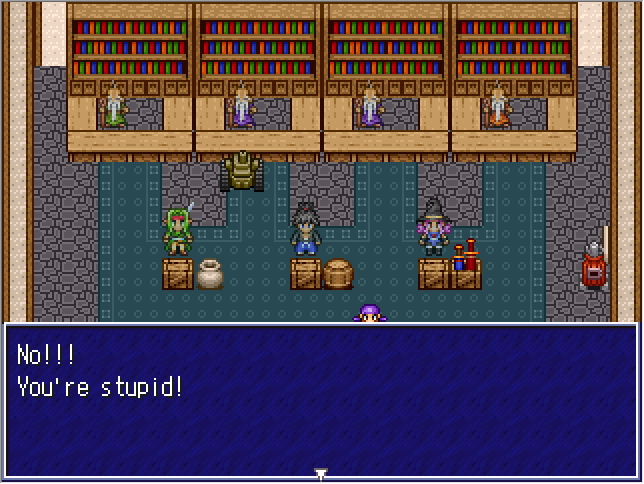
|
TARG:
an obscure and local form of what we'd now call shitposting, with emphasis on mangled syntax and a kind of frantic, empty commercial spieling. at one point resulted in a series of rpg maker games. recurring targ trickster entity "doug beach" has since transitioned to a successful career in indie games, in a good example of the kind of shadowy interplay which can occur between the two realms. |
|
WALK SPEED:
contentious. iirc RM2K3 had about 7 different walk speeds, of which only 2 were really usable for a player character, giving you the choice between "slightly too fast" and "slightly too slow". it was kind of offputting to have some glowering, stoic mercenary character zipping around like a bee on top of an elaborately detailed and atmospheric location, but the alternative of slowing down the player to force a sense of mood and pacing did not generally go over that well. it kind of resembles ye olde artgame debates around deliberately frustrating mechanics and their power when setting a mood - unfortunately somebody making a hobbyist rpg maker game played mostly by other hobbyist developers is not really as able to lay claim to the same sense of authority or artistic highmindedness, at least without being made fun of. i believe later games tended to make do with the workaround of a dedicated run button, while slow walking speed became not nearly as much of a problem in the context of small, atmospheric horror games rather than deliberately sprawling fantasy rpgs. |
|
OTHER ENGINES:
the elusive rpg maker 3d, of course; later there'd be XP and VX as well, which were both hideously shorn-looking at first in comparison to the slow tectonic piling of graphical crust and resource stockpiling that'd been going on for 2k/3 all this time. there was a later rumoured "indie game maker" (the genre shift maybe should have been read as a sign of the times in retrospect) by enterbrain as well, which would enable you to make shooters and platformers and such instead. there was game maker and similar which never really caught on in this particular scene, and which were distinct enough in terms of scripting and process that anything done in them was essentially magic. and also a raft of smaller and more despised rpg making tools like Sphere, Ika and RPG Toolkit - more despised because they had less access to the enormous RM2k/3 resource heap, and also in all likelihood because they seemed to require actual code as opposed to event scripting. and so they languished on in subforums ruthlessly separated from the main board, eventually being taken away in silence, like dead pets. |
|
TVTROPES:
an obscure volume of religious instruction. |
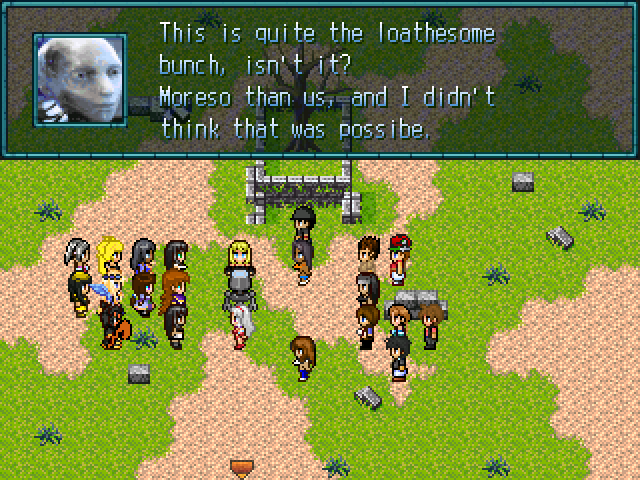
|
ART:
i suspect that because so little money was involved in rpg maker circles the idea of art was felt to be more or less irrelevent. a focus on art seems to mostly come into being when trying to either accent or counterbalance large amounts of capital. |
|
CONTEST:
i actually don't recall the "game jam" terminology being universal at this point but maybe i'm wrong. anyway RM2K3 has a lot of positive elements but usefulness at fast, small-scale game development is not really one of them, turning game contests into a form of russian roulette mixing neutral and disagreeable sets of outcomes: 1. you release a game (good ending) 2. you don't release anything (neutral ending) 3. you release a game and then decide to keep working on it as a new side project (bad ending) 4. you don't release a game but then decice to keep working on it as a new side project anyway (worse ending) 5. you decide to turn your jam entry into a standalone tie-in to the fictional universe and characters of your main project, which has not yet been released (instant death). |
|
LOCKING:
is this what it was called? when games ran some kind of freeware encryption package on their finished RM build, so that instead of being able to access it through the editor you had to either install it or just play the EXE... was generally seen to be somewhat high-falutin' but acceptable in cases of games with lots of original assets, which somebody might not want recirculating endlessly thru the collective RM resourcescape, but totally unsportsmanlike and presumptuous in the case of a game which itself used stolen assets. although from reputation the difficulty of getting at the "encrypted" files made this more or less abstract as an ethical issue. |
|
SEX:
now that i have your attention ha ha ha no, i don't recall this being very prominent at the time - it popped up in some of the more "mature" horror or postapocalypse type games, mostly as startling nude overlays taken from a manga or something. (i do remember a game with a line of dialogue like "come fuck me, boyo. this sweet irish lass needs your c*** *** ******" etc. wasn't this the plot of 'trilby'?!). there WAS a jam game called "marvel brothel" which was a strangely mechanically-focused simulator type deal about, uh, professor x turning the x mansion into a brothel and then doing a rollercoaster tycoon type upgrade loop from there, like getting special power bedsprings for in case the hulk comes by or such... but ultimately what most comes to mind is the tender love story in Love & War Act 1, which i remember as being such a shameless and naked piece of authorial wish fulfilment that my teenage self both enjoyed it and felt desperately embarrassed by proxy over it. and the main other thing i remember about that story is that the girl character was called Lavie and she had her own episodic spin-off game, which with that same wonderful shamelessness was titled "C'est Lavie!". basically, this is all there is to know about sex. |

|
HORROR GAMES:
the games that i most associate with RM communities now are possibly the ones least associated with them today: the wide-ranging fantasy rpg seems, if not totally displaced, at least slightly downgraded in status compared to horror games. for the most part i think these games exist in a lineage coming from yume nikki and ao oni, japanese games which if anything gained most of their audience outside the traditional western RM scene. but it's interesting to look at cases of parallel evolution, and there were actually quite a few different early western attempts at RM horror games as well, mostly with quite a different atmosphere, gameplay and emphasis to the more wellknown strands. firstly, closest to the more atmospheric emphasis of the likes of yume nikki, are games like Grave Spirit - dense, murky graphics, lots of overlays and lighting effects, more of an emphasis on puzzles, which also seemed to have a big effect on the german RM scene. secondly, and more interestingly to me, are the games which had a gorier and more pulpy atmosphere but which drew more on american horror of the clive barker or se7en variety - games like yeaster's Onyx, and the famous misterbigt Dooms series. what interested me about these is that the scrambled mix of genre influences - jrpgs and horror and "urban fantasy" and police / murderer procedurals - were matched with a scrambed aesthetic, noticeable even by rpg maker standards. images would be pulled at any size from sources ranging from bahamut lagoon to disconnected promo shots of actors in buffy or on cop shows to just miscellaneous horror art found online, or monster art taken from hentai, and these would be mixed in with the stock rpg maker graphics or with scrabbled-together "modern" tiles taken from final fantasy 6 or something. and i think this unstable mix of genres and atmospheres was sort of overtaken by the more streamlined and adaptable j-horror type aesthetic, maybe with good reason. but it still feels like an interesting, underrecognized micro-direction to me, a good illustration of the strange places these things can go when it feels like no-one's looking. |
|
SCRIPTING:
before Ruby was introduced in later versions of RM i believe all of this had to be done through the generic event editor, which being intended solely for amateurs working on one very specific type of game tended to consist entirely of commands like "move player up", "subtract HP", "teleport" and "add [greenherb]". there was a way to track and change variables and certain slightly more flexible functions, like "play battle animation" (or just play an animation somewhere on the screen), "show picture" and ways to set up events that would loop constantly in the background rather than being triggered by walking into them. it is probably more inevitable than surprising that people would still use this very limited toolset to make shooting games, beat-em-ups, board games... in memory a platformer and even a very crude 3d maze. a lot of time was put into things which offset the "feel" of an RM game, the basic underlying structures which remained the same from game to game: menus and battle systems were replaced by "custom menu systems" and "custom battle systems" (CMS, CBS). but i remember the true marks of distinction as being able to alter the generic new/load/exit window in the title screen, and adding your own name to the title cards that popped up when the game was launched. this has been a stephensoft production. |
|
CHARAS PROJECT:
i've written before about how the easiest way of finding resources for rpg maker was just by downloading the biggest demo you could find and cherrypicking from its resource folder - - which was probably morally neutral anyway since they likely had already done the same thing, or at most had set aside time to scrape up the work of an anonymous square-enix employee from 1996. but there were also dedicated resource sites where you could search by specific word ("swamp" "modern" etc). and there were people working to fill up those sites, and putting slightly doomed-feeling credit me pictures at the bottom of their character sets. i think my favourite one was the mysteriously still-active charas-project.net, which had a wonderfully overgrown feeling resource dump section you could sift through to find character sprites of George W Bush and Smashing Pumpkins among others. the crown jewel of that site was the character generator feature, an in-browser tool that let you combine hundreds of template bodies, hairs, suits and accessories to create your own little guys. the assets to pick from were user submitted and ran the gamut from careful edits and original work to fan recreations to mspaint doodles to hyperspecific things seemingly designed to just fill a niche, such as "mouse suit" and "smurf". i can't speak for anyone else, but to be honest, i think the vast majority of the time i spent "game developing" was just sitting on this site, trying out various combinations of features and costumes, filling out and tinkering with some private endless character roster which would abruptly expand or change directions whenever i would run across a new thing i would like... now this person was a pirate captain, now they were a party member, now they were an optional boss that lived in a mansion on a vampire planet (soundtrack: "moonlight sonata", earthworm jim 2), now they were the end boss of the game, or a member of a secret consortium of twelve various and powerful entities which etc. all of which shows that all sufficiently developed fantasy tends inexorably towards kingdom hearts. but to me this was something at the very core of the appeal of rpg maker, a strange kabbalistic permutative process of endless, directionless shuffling and reconfiguration, punctuated by odd feelings of progress, of discovery. |

|
TERRA OBSCURA:
every so often somebody posts a screenshot from one of the french-speaking rpg maker communities, who are doing much more advanced things with lighting overlays and custom panorama effects and every so often one of these games is actually translated and meets with mixed reception: the huge, glossy areas feel too much somehow, like you're crawling around an enormous cake. it feels like an exotic flower which goes limp and sticky when removed from the very specific conditions of the hothouse it emerged from. beyond france and germany there is limited word, although character sheets and tilesets sometimes filter in from those dedicated enough to browse the network of japanese hobbyist sites. |
|
OUR NEIGHBOURS:
there's gamemaker and apparantly some shootemup forum but really who cares? rpg maker is specific enough as a genre, as a set of resource considerations, as a set of technical considerations, that i don't remember feeling as though there would be any use in pulling from those examples. maybe people older than me at the time were more aware of it, but: i don't believe the idea of a common "game design" sensibility, which existed as something outside of any particular genre or engine context, had really penetrated these circles at that point. and in fact based on the writings (blogs, etc) i saw about it at the time the "game design" discussions in the indie world, the "brainysphere" etc, seemed like just another abstract rhetorical cult among many, neither more powerful nor more intellectually compelling than any of the loose forum groupings devoted to arguing for custom battle systems as opposed to the default, or similar. the expanded sense of community and example that came with "game design" was welcome, but it did come with a depreciation of the sort of scrappier, more material things that hovered around the scene - technical demos or expansions, strange community chain games or things like OHRRPGCE House or the Alex series, the strange recycling of assets and happy obliviousness to copyright laws that it entailed. |
|
POSTSCRIPT:
i've always been kind of a mimic. when i joined gamingw.net around 2004/2005 it was already something of an established site, with its own references, in-jokes, subgroups, histories, forms of language, etiquette, and i remember reading through a lot of archived threads, sinking into that, trying to internalize the rules of this new culture. the above was all written based on what i remembered having learned. i can't say whether any of it's accurate, but i hope it gives a sense of the kind of fishbowl insularity that stands out most about the small game development scenes of that period, before they were all retroactively pulled into the wake of a single "indie movement", and when they were largely not paying attention to that movement. i hope in 15 years the idea of people making indie games without knowing or caring what others were simultaneously doing in art or music or comics or writing will seem as blinkered and unlikely as someone on an rpg maker forum exercising bland disinterest in the doings of all the other rpg maker forums, while taking forgotten demo releases as the limits of the known world. |
